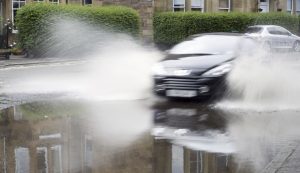
It is fair to say that the UK has experienced several mild winters recently so may have become out of practice in preparing for, and driving in wintery conditions. With that in mind, it is important to remind or revise yourself on the various issues involved at this time of the year. The following are some winter driving tips to help keep you safe.
Our driving experience can be vastly improved if we are confident that our vehicle is winter-ready and that we are prepared for our journey. Following our winter driving tips will send you in the right direction.
A vital part of vehicle preparation is to ensure that our tyres are in a suitable condition. They should be checked for cuts, bulges or any damage to the side walls and the tread depth should be checked too. Although the legal limit in the UK is 1.6mm, it is recommended that you change your tyres once they reach around 3mm. This is more so important in rain or snow as the extra tread depth will better disperse any snow or water. The depth can be checked by looking for the tread wear indicator or by using a tread depth indicator (see image).


If you live in an area where snow or ice are likely and you depend on driving, you might want to consider changing to “all season tyres”, which don’t harden at temperatures below 7C and therefore offer much better grip. It is more economical and safer to drive an all season tyre all year round than a standard “summer tyre”. It is also important to remember that your tyre pressures should be checked to allow for any change in load. So, your pressures will be different if you have a car full of people plus luggage. You can find the information in the vehicle handbook, and remember to check the spare tyre too.
Check the condition of the wiper blades, they must clear well and not smear. Don’t use the wipers to clear frost, it may irreplaceably damage them.
All fluids should be checked and topped up as necessary. This must include the windscreen washer fluid with the correct concentration of anti-freeze. If you are concerned about the environment (most ready mixtures include Methanol, which is highly toxic). You can mix your own at a ratio of around 10:1 (10 parts of water, 1 part of Isopropyl Alcohol usually will prevent freezing to -5C, double the amount of Alcohol if you expect temperatures below -5C). Isopropyl Alcohol can be bought on the internet at less than £20 / 5L, which will get you through several winters.
Check the coolant is at the correct concentration to prevent freezing – your local garage will have a tester, or if nothing at hand, you could take a sample and place it in your freezer compartment of the fridge.
Weather and light levels are more likely to reduce visibility in the winter period. It is important to carry out regular checks of all bulbs and lenses. It is also beneficial to clean all glass, both inside and out. Air conditioning can create a build-up of grease on the inside of the windscreen, which can cause smears and glare in the low winter sun.
Finally, we tend to use more electrical systems in bad weather which puts more of a strain on the battery. Therefore, you should make sure that your battery is in good condition.
It would be reasonable to expect a journey to take longer in the winter than summer so calculate this in when planning your journey. You should also plan in your rest stops which will also allow you to maintain a plentiful supply of fuel. This may be important in the cold weather if you encounter a major traffic jam and need to run the engine to keep yourself warm.
Make sure that you have traffic announcements switched on, on your radio. This may allow you to divert away from any traffic issues ahead.
However, if you are unlucky enough to be stuck on a road for a prolonged period of time, you may be thankful that you have packed the correct equipment in your car before setting off:
With the colder weather comes the increased possibility of fog playing a part in our travels. When driving in fog, or other weather conditions where visibility is reduced, you should drive with your dipped headlights on. Avoid using your main beam as the higher beam of light can reflect from the fog. Once visibility is reduced to around 100m, you should use your rear fog lights. Be sure to turn them off if visibility improves (judge by how soon you can spot cars in front of you with / without fog lights).
Front fog lights don’t make your car more visible than your normal headlights do. Instead, they cut through the fog and light up the surface of the road to give you better vision of the edge. This will help you stay in lane in darkness and fog – during the day they have no effect. Fog is fine water droplets, therefore use of windscreen wipers may be necessary. Be wary of the fog clearing, only a bit further down the road you may be back in it.

When driving in fog remember the golden rule; always leave a big enough clear gap between you and any potential obstruction or vehicle in front. This should be big enough for you to safely stop in. Don’t fool yourself by following the rear lights of the car in front, there may not enough room between that car and the one in front.
If visibility becomes too poor, simply pull over in a safe place and stop.
Make sure you are aware of what is behind. There may not be enough room behind you for the following vehicle to react in time, and therefore you may have to slow down.
Usually driving in rain in Britain is quite a normal event. However heavy downpours are more likely to occur in the winter and are more likely to cause localised flooding. The general rules and tips are similar to fog, again making sure you always have enough room to stop in. Surface spray can severely reduce visibility and you should use your fog lights.
You will need double the stopping distance as compared to a dry road.
Watch out for large pools of water, they could cause drag and force the car to swerve left or right and they may hide pot holes. The upward splash could severely hinder visibility and the car could aquaplane.

Aquaplaning occurs when a wedge of water forms under the front edge of the tyre, lifting it from the road surface. This results in the loss of control over braking, acceleration and steering. Signs are:
Try not to steer and do not use the brakes as the car could spin – let the car gently regain control.
Two of the main contributing factors are the condition of your tyres and the speed of your car. With that in mind, it is important that your tyres are in good condition, with plenty of tread remaining. It is also important that you drive at a speed appropriate to the road and traffic conditions.
If you encounter flood water, reduce speed and try to ascertain how deep it is. Most cars will deal with water up to about 150mm, about 6 inches. Unless in a 4X4, anything deeper is risky. Do not attempt if the water is fast flowing. If you think you can drive through, use first gear and do not exceed 5mph. High revs and slow speeds prevent a bow wave which could cause water ingress into the engine air intake This is extremely damaging to the engine. The high revs help to prevent water ingress through the exhaust.
Allow oncoming traffic to progress first and aim for the shallowest part of the water.
Ice is one of the most hazardous problems on the road, simply because you cannot see it. When setting out, make sure all the windows are clear. Use the ancillary controls to direct the air flow towards the windows and switch on the heated rear screen and front, if fitted. Allow all windows to clear before moving off.
Most modern cars have a frost or ice indicator, which, in most cars, comes on at 4°C. This is because the road surface could be a lot colder and below 0C. There may be stretches of road which are constantly in shadow because of trees or hedgerows. These stretches could easily be hiding icy patches.
When driving downhill select a low gear to prevent the car from speeding up. Select 1or 2 instead of D in automatics or manually select a lower gear if equipped with paddle shifters or similar. You should also prepare to make use of the clutch to avoid transferring too much power. Keep the car as smooth as possible, both with steering and with clutch/gears. Brake earlier and more gentle than normal to avoid locking the wheels.

If you negotiate corners very slowly and with gentle steering, you will reduce the chance of skidding. If the vehicle skids, you should ease off the accelerator or brake (remove the cause of the skid) You then steer gently into the skid until you regain full control.
Avoid over revving the engine if you are stuck in snow. This will spin the wheels and dig your car in deeper. Carefully balance the clutch at biting point to avoid transferring too much power. Place some grit or material under the driving wheels and dig out any snow build up in front of the wheels. Gently move the vehicle forwards and backwards to creep out. If you are definitely stuck then you should stay with your vehicle until help arrives. To abandon your vehicle could hold up the progress of rescue vehicles.
Listen carefully to weather forecasts and warnings issued by the Met Office. If they advise you to avoid driving then, wherever possible, heed the warnings and stay at home.
However, if you MUST drive then ensure that you prepare your vehicle and equipment well and allow plenty of time to complete your journey.